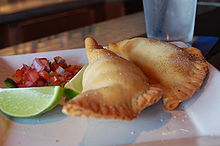Empanadas

Two empanadas (empanadillas)
|
|
| Course | Appetizer |
|---|---|
| Place of origin | Spain, Portugal |
| Region or state | Latin America, Europe |
| Creator | Spain |
| Serving temperature | Hot or cold |
| Main ingredients | Pastry, filling |
| Variations | Pastel, Pasty |
| |
|
An empanada (Spanish pronunciation: [empaˈnaða]) is a stuffed bread or pastry baked or fried in many countries in Spain and Latin America. The name comes from the Spanish verb , meaning to wrap or coat in bread.
Empanadas are made by folding dough over a stuffing, which may consist of meat, cheese, huitlacoche, or other ingredients.
Empanadas trace back their origins to the northwest region of Spain, Galicia. A cookbook published in Catalan in 1520, Libre del Coch by Robert de Nola, mentions empanadas filled with seafood in the recipes for Catalan, Italian, French, and Arabian food.
Some sources claim a connection with the Indian cuisine. A similar dish first appeared in Portugal around the time of the establishment of trade routes to India and the establishment of a colony at Goa. This is believed to have been derived from or influenced by the Indian Gujia or Samosa, known in Lisbon as the Chamuça da Goa.
Argentine empanadas are often served during parties and festivals as a starter or main course. Shops specialize in freshly made empanadas, with many flavors and fillings.
The dough is made with wheat flour and beef drippings for the fillings which differs from province to province. Some places use chicken, and some places beef (cubed or ground depending on the region) spiced with cumin and paprika. Some other fillings are onion, boiled egg, olives, or raisins. Empanadas can be baked (Salta-style) or fried (Tucuman-style). It also can contain ham, fish, humita (sweetcorn with white sauce), or spinach; a fruit filling is used to create a dessert empanada. For the interior regions, they can be spiced with peppers.
...
Wikipedia
